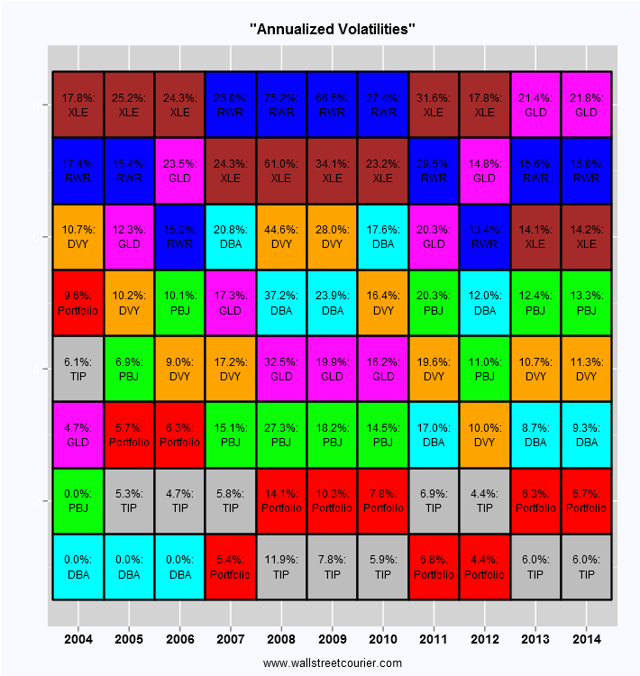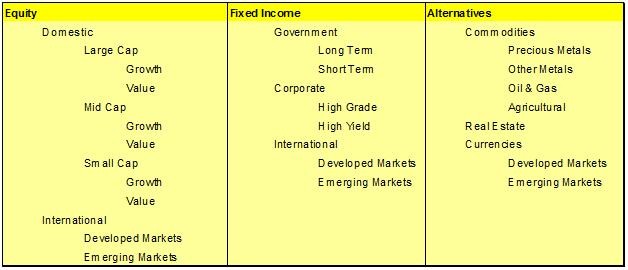How To Construct A Diversified Bond Portfolio For Retirees
Post on: 16 Май, 2015 No Comment

Although bond funds have offered meager returns over the past few years, they are still an important asset class, especially for retirees who want to minimize risk. Most investors realize the advantages of diversifying their equity portfolio, but many retirees don’t give the same importance to diversifying bonds. This article discusses the different classes of bond funds and how they can be combined to generate a better return while still limiting risk. There are many types of bond risk (interest rate risk, credit risk, inflation risk, etc.) but for this analysis, I will define the portfolio risk to be synonymous with volatility
For this analysis, I used the iShares Core Total US Bond Market (NYSEARCA:AGG ) as the anchor for my portfolio. This ETF contains treasuries, mortgage-based securities, and corporate bonds, and is widely used a proxy for the US investment grade market. Since AGG only yields 1.7%, my objective is to combine other bond ETFs with AGG in such a way that will provide a better return without significantly increasing risk.
There are hundreds of bond ETFs that I could have chosen but for this analysis, I selected highly liquid representatives of different bond classes. The ETFs that I considered are:
US Treasuries. These bonds are backed by the US Government so have no credit risk but do have interest rate risk.
- iShares Barclays 1-3 Year Treasury Bond (NYSEARCA:SHY ). This ETF has an average duration of 1.8 years and a yield of 0.3%.
- iShares Barclay 3-7 Year Treasury Bond (NYSEARCA:IEI ). This ETF has an average duration of about 4 years and a yield of .67%
- iShares Barclay 7-10 Year Treasury Bond (NYSEARCA:IEF ). This ETF has an average duration of about 7.6 years and a yield of 1.69%
- iShares Barclay 20+ Year Treasury Bond (NYSEARCA:TLT ). This ETF has an average duration of about 16.9 years and a yield of 2.87%
Inflation Protection Securities. Inflation risk is the possibility that your return will be less than inflation, basically reducing the buying power of your investments. Bonds that have yields tied to the Consumer Price Index [CPI] are said to be the inflation protected.
- iShares Barclay TIPS Bonds (NYSEARCA:TIP ). This ETF is the largest fund for Treasury Inflation-Protected Securities. This fund currently has a yield of only 1.63% since inflation is perceived to be under control. TIPS are a special class of Treasury Bonds, so there is no credit risk. The duration is 8.28 years.
Asset-Backed Bonds. These are financial securities backed by tangible assets, such as loans, leases, credit card debt, or real estate. Mortgage-Backed Bonds [MBB] are a specific class of asset-backed bonds that are backed by mortgages. An excellent representative of this class is:
- iShares Barclay Mortgage Backed Securities Bonds . This ETF owns MBBs issued by the Government Sponsored Enterprises: Fannie Mae (OTCQB:FNMA ), Freddie Mac (OTCQB:FMCC ), and Ginnie Mae. These bonds have the implicit guarantee of the US Government, so there is virtually no credit risk. The duration is short at 3.2 years, so this is a relatively good investment in a rising interest rate environment. The yield is 1.32%
Corporate Bonds. Corporate Bonds are debts issued by corporations. The backing is usually the ability of the corporation to earn sufficient income to service the debt. Unlike Treasuries, corporate bonds have the risk of default. These bonds are rated as to credit worthiness by independent organization such as Moody’s and Standard and Poor’s. Bonds that are very likely to maintain payments are considered to be investment grade. If the company is assessed as having a lesser probability of meeting its bond commitments, then the bonds are called non-investment grade. Other names used for non-investment grade securities are junk bonds and high yield bonds. ETFs representing corporate bonds are:
- iShares iBoxx $ Investment Grade Corporate Bond (NYSEARCA:LQD ). This ETF is comprised of over 1000 bonds with an average duration between 7 and 8 years. The yield is 3.96%.
- iShares iBoxx $ High Yield Corporate Bond (NYSEARCA:HYG ). This ETF has over 700 holdings with an average duration of 3.9 years. The yield is relatively high at 6.56%.

International Bonds. International bonds are debt instruments issued by foreign governments. Two ETFs that represent this class are:
- SPDR Barclays International Treasury Bond (NYSEARCA:BWX ). This ETF tracks a collection of over 400 investment grade bonds issued by foreign governments. The bonds are issued in local currency, so there is currency risk in addition to typical bond risk. The top three countries are Japan, France, and the United Kingdom. The duration is about 7 years and the yield is 2.17%.
- iShares JPMorgan USD Emerging Markets Bond (NYSEARCA:EMB ). This ETF tracks a collection of over 200 bonds issued by 39 governments of emerging market countries. The bonds are issued in US currency so there is not any currency risk. The top five countries represented are Russia, Brazil, Mexico, Turkey, and the Philippines. The duration is about 7.7 years and the yield is 4.6%.
To analyze risks, I plotted the rate of return in excess of the risk free rate of return (called Excess Mu) against the historical volatility for each of the ETFs over the past 5 years. This data is provided in Figure 1 and was generated via the Smartfolio 3 program (www.smartfolio.com ).
(click to enlarge)
Figure 1. Risk versus Reward for Bond ETFs over 5 year
As is evident from the figure, there was a relatively large range of rates of returns and volatilities. For example, LQD had a high rate of return but had a higher volatility than AGG. Was the increased return worth the increased volatility? To answer this question, I calculated the Sharpe Ratio.
The Sharpe Ratio is a metric, developed by Nobel laureate William Sharpe, that measures risk-adjusted performance. It is calculated as the ratio of the excess return over the volatility. This reward-to-risk ratio (assuming that risk is measured by volatility) is a good way to compare peers to assess if higher returns are due to superior investment performance or from taking additional risk. In Figure 1, I plotted a red line that represents the Sharpe Ratio associated with AGG. If an asset is above the line, it has a higher Sharpe Ratio than AGG. Conversely, if an asset is below the line, the reward-to-risk is worse than IEF.
Some observations are evident from Figure 1.
- Obviously, TIP and BWX had less return with more risk than AGG, so I deleted them from consideration.
- MBB and IEI had better Sharpe Ratios than AGG, so they were retained.
- SHY, IEF, and LQD had about the same Sharpe Ratio as AGG so these ETFs were also retained.
- EMB and TLT had poorer performance than LQD (about the same return but with significantly more volatility) so I dropped them.
- HYG was a special case; it had a very good return with only a slightly poorer Sharpe Ratio, so I decided to retain HYG as a potential component of the portfolio.
The next step in constructing the portfolio was to make sure that it was diversified. To be diversified, you want to choose assets such that when some assets are down, others are up. In mathematical terms, you want to select assets that are uncorrelated (or at least not highly correlated) with each other. Therefore, I calculated the pairwise correlations associated with the remaining ETFs. The results are shown in Figure 2.
(click to enlarge)
Figure 2. Correlation Matrix Bond ETFs over 5 years
With the exception of SHY and IEI, the bond ETFs are not highly correlated with one another. I therefore deleted SHY and IEI from the consideration and combined the remaining ETFs to develop a diversified portfolio anchored around AGG. The result is shown in Figure 3, where the composite portfolio is shown as a yellow dot.
(click to enlarge)
Figure 3. Optimized ETF Bond Portfolio 5 Years
When the 5 ETFs are combined into an equally weighted portfolio, the resultant is a portfolio that has a 40% greater return than AGG with a volatility 6% less than AGG. This is an illustration of the amazing discovery made by an economist named Markowitz in 1950. He found that if you combined certain types of risky assets, you could construct a portfolio that had less risk than the components. His work was so revolutionary that he was awarded the Nobel Prize. One of the keys to achieving this reduction in risk is to combine assets that are relatively uncorrelated with one another.
My original objective was accomplished; I used different bonds classes to construct a portfolio that outperformed AGG. Please note that I am not making any claims that this is the best portfolio; my claim is only that the portfolio met my objectives.
To check to see if the good performance still held during the more recent past, I shortened the look back period to 3 years and re-ran the analysis. The results are shown in Figure 4.
(click to enlarge)
Figure 4. Risk versus Reward Bond ETFs 3 years
This figure shows that the composite portfolio had a substantially better return with about the same volatility as AGG.
Bottom Line
So my conclusion is that, at least over the time frames analyzed, combing MBB, LQD, IEF, and HYG with AGG produced excellent results. These results may not hold in the future, but the general idea of combining different bond funds together into a diversified portfolio is an idea that retirees should definitely consider.
Disclosure: I have no positions in any stocks mentioned, and no plans to initiate any positions within the next 72 hours. I wrote this article myself, and it expresses my own opinions. I am not receiving compensation for it. I have no business relationship with any company whose stock is mentioned in this article.














